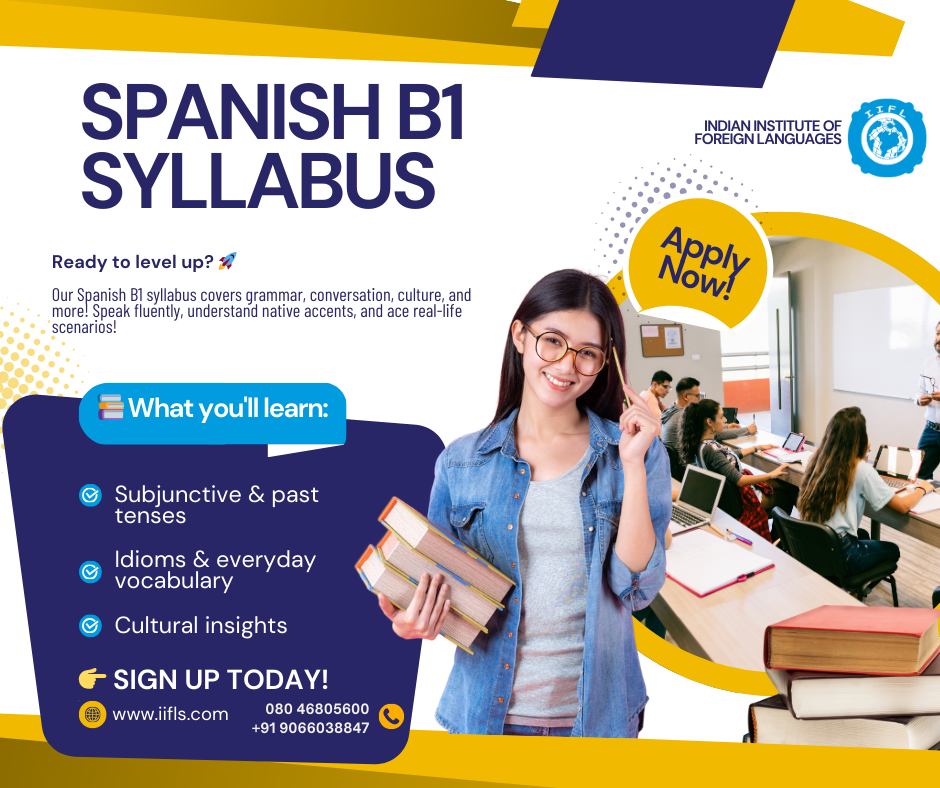Spanish B1 Syllabus – Achieve Intermediate Proficiency in Spanish
What is the B1 Level in Spanish?
The B1 level in Spanish marks the transition from beginner to intermediate proficiency according to the Common European Framework of Reference for Languages (CEFR). At this stage, learners can handle real-life conversations, understand everyday texts, and express ideas with more fluency and accuracy.
Mastering Spanish at the B1 level is a significant milestone in language learning. It is often referred to as the threshold level, where learners gain the ability to communicate effectively in everyday situations. This guide provides a detailed breakdown of the Spanish B1 syllabus, ensuring you understand the skills and knowledge required to excel.

Understanding the B1 Level in Spanish
The B1 level is categorized by the Common European Framework of Reference for Languages (CEFR) as an intermediate stage. At this level, learners should demonstrate independence in their ability to:
- Handle daily interactions with native speakers.
- Understand and produce simple texts on familiar topics.
- Discuss past experiences, future plans, and opinions.
Core Skills in the Spanish B1 Curriculum
1. Intermediate Listening Comprehension (Comprensión Oral Intermedia)
Listening Skills as explained in Spanish B1 level program
At the B1 level, listening comprehension focuses on understanding the main points in conversations or broadcasts on familiar topics. Learners should be able to:
- Follow spoken narratives about daily life, work, or leisure.
- Understand the gist of radio or TV programs about current events.
- Grasp the meaning of announcements and instructions in public settings.
Practice Tips:
- Listen to Spanish podcasts tailored for intermediate learners.
- Watch Spanish movies or series with subtitles to improve vocabulary and comprehension.
- Engage with native speakers through language exchange platforms.
B1 learners develop better listening skills by:
- Understanding main ideas in conversations about work, school, and leisure activities.
- Following simple explanations and instructions in everyday situations.
- Recognizing opinions and attitudes in spoken Spanish, even at a natural pace.
2. Stronger Reading Abilities (Lectura en Nivel Intermedio)
Reading proficiency at B1 involves understanding texts that convey specific information or opinions. By the end of this level, learners should:
- Comprehend short stories, news articles, and advertisements.
- Extract key information from brochures, schedules, and public signs.
- Understand opinions and arguments in basic opinion pieces.
Practice Tips:
- Read Spanish newspapers such as El País or La Vanguardia.
- Explore blogs and forums on topics of personal interest.
- Use graded readers designed for B1 Spanish learners.
At B1 proficiency, students can:
- Read and understand newspaper articles, blogs, and personal letters.
- Extract relevant information from travel guides, advertisements, and job descriptions.
- Comprehend structured texts on familiar or personal topics.
3. Engaging in Conversation (Expresión Oral con Más Fluidez)
Speaking Skills
At the B1 level, speaking focuses on maintaining conversations and expressing oneself fluently on familiar topics. Learners should:
- Participate in discussions about personal interests and daily activities.
- Describe past experiences, ambitions, and plans.
- Provide clear explanations for preferences and decisions.
Practice Tips:
- Practice with a language partner or tutor regularly.
- Use role-playing techniques to simulate real-life situations.
- Record yourself speaking on various topics to identify areas for improvement.
A B1 Spanish speaker can:
- Participate in conversations on familiar topics, such as work, hobbies, and current events.
- Express personal opinions and feelings in social interactions.
- Handle travel situations, customer service interactions, and informal discussions with ease.
4. Writing with More Detail (Redacción en Español Intermedio)
Writing at the B1 level emphasizes the ability to create structured and coherent texts. Learners should:
- Write emails, notes, or informal letters on topics of personal interest.
- Produce short essays or reports describing experiences, plans, or arguments.
- Use appropriate linking words to connect ideas logically.
Practice Tips:
- Start a journal to document daily activities in Spanish.
- Write summaries of articles or movies you’ve read or watched.
- Participate in online forums and respond to discussions.
At this level, students improve their writing skills by:
- Writing connected text on topics of interest, such as travel experiences or personal achievements.
- Composing emails, messages, and reports with clear structure.
- Using linking words and cohesive devices to organize ideas effectively.
Key Grammar Structures in the Spanish B1 Syllabus
Grammar and Sentence Structure
A robust understanding of grammar is crucial at the B1 level. Key grammatical concepts include:
- Past tenses: Preterite, imperfect, and present perfect.
- Future tense and conditional forms.
- Use of subjunctive mood in basic expressions.
- Mastery of pronouns, including reflexive, indirect, and direct object pronouns.
- Understanding comparatives and superlatives.
Practice Tips:
- Use flashcards to memorize irregular verbs and their conjugations.
- Complete exercises focusing on sentence construction.
- Incorporate grammar apps like Duolingo or LingQ for interactive learning.
B1 learners focus on:
- Past Tenses in Detail – Using preterite vs. imperfect for storytelling.
- Conditional Sentences – Expressing hypothetical situations.
- Indirect Speech – Reporting conversations and past events.
- Pronouns & Relative Clauses – Improving sentence complexity and coherence.
Expanding Vocabulary for Real-Life Situations
Vocabulary Expansion
At B1, the emphasis is on expanding vocabulary to include a wide range of topics such as:
- Travel and holidays: Booking accommodations, asking for directions.
- Health and well-being: Medical terms, symptoms, and treatments.
- Work and education: Job interviews, office terminology, academic discussions.
- Leisure activities: Hobbies, sports, and cultural events.
Practice Tips:
- Use flashcard apps like Anki to reinforce vocabulary retention.
- Create word associations and mnemonics to remember challenging terms.
- Engage in themed conversations to solidify contextual vocabulary use.
The Spanish B1 syllabus introduces a broader vocabulary range, covering:
- Work & Career – Discussing job responsibilities, work environments, and professional skills.
- Travel & Culture – Describing experiences, comparing destinations, and making travel arrangements.
- Technology & Social Media – Talking about online habits, digital tools, and communication.
- Emotions & Relationships – Expressing feelings, giving advice, and describing personalities.
How to Prepare for the Spanish B1 Exam?
To succeed in a B1 Spanish proficiency test, learners should:
- Watch Spanish TV shows, interviews, and news for better listening skills.
- Engage in extended conversations with native speakers.
- Write journal entries and opinion pieces to practice structured writing.
- Use online exercises and practice tests to improve grammar accuracy.
Advantages of Reaching B1 Fluency in Spanish
Attaining a B1 Spanish level enables learners to:
- Communicate effectively in professional and social settings.
- Understand and discuss personal interests and current topics.
- Travel independently in Spanish-speaking countries.
Importance of Cultural Context as in Spanish B1 syllabus
Understanding Spanish culture is integral to mastering the language. At the B1 level, learners are encouraged to explore:
- Spanish festivals such as La Tomatina and Semana Santa.
- Regional dialects and accents across Spain and Latin America.
- Popular cultural icons in music, film, and literature.
Practice Tips:
- Attend virtual cultural events hosted by Spanish-speaking communities.
- Watch documentaries about Spanish traditions and history.
- Read books or watch shows highlighting regional diversity.
Tools and Resources for B1 Spanish Learners
- Language Learning Apps:
- Duolingo
- Babbel
- Rosetta Stone
- Online Courses:
- Enroll in structured programs that include grammar, vocabulary, and conversational practice.
- Practice Platforms:
- Use language exchange sites like HelloTalk or Tandem.
- Participate in online forums like Reddit’s r/Spanish.
- Printed Materials:
- Invest in textbooks like “Prisma B1” or “Gramática de Uso del Español”.
- Utilize vocabulary and grammar workbooks.
How to Measure Progress at the B1 Level
Tracking progress ensures learners stay on course. Consider the following benchmarks:
- Ability to participate in spontaneous conversations without significant pauses.
- Confidence in understanding and discussing audio and written texts.
- Successful completion of practice tests for the DELE B1 exam.


